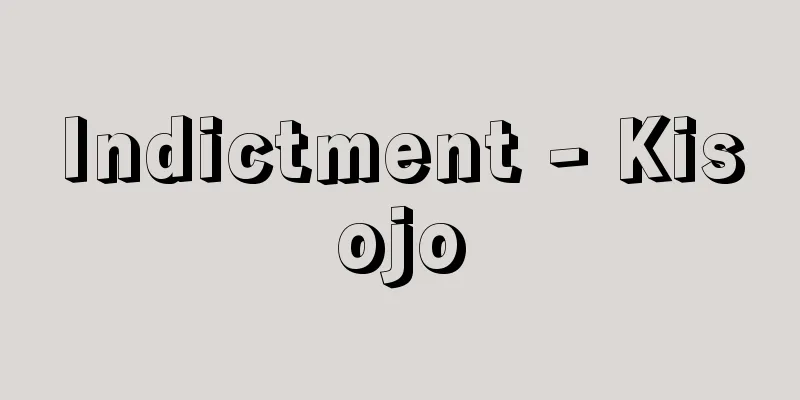Kamakura Shogunate

|
A military government established in Kamakura by Minamoto no Yoritomo. [Masayoshi Kamiyokote] Political Processes and InstitutionsAfter the Heiji Rebellion (1159), Yoritomo, who had been exiled to Izu, raised an army to overthrow the Taira clan in August 1180 (Jisho 4) in response to the orders of Emperor Mochihito. Yoritomo soon established his base in Kamakura, Sagami, where he established a samurai office to control his retainers and managed the "eastern provinces" east of Totomi. A residence for Yoritomo (architecturally, this was the Shogunate) was also built, and in December of the same year, a ceremony to mark his move to the new residence was held in the presence of his retainers, which marked the announcement of the establishment of a new government. For the next three years, the new government ruled the eastern provinces as a nation independent of the Imperial Court in Kyoto. However, Yoritomo had also secretly allied with Emperor Goshirakawa from the beginning of his uprising. Therefore, when the Taira clan fled the capital in 1183 (Juei 2) and the Cloistered Emperor's Insei system was restored to function, negotiations between the Cloistered Emperor and Yoritomo progressed rapidly, and the Imperial Court formally recognized Yoritomo's rule over the eastern provinces by issuing an Imperial decree in October, the second year of Juei (1183). Thus, the independent states of the eastern provinces were dissolved, and the eastern provinces were restored to the control of the Imperial Court. In 1185 (Bun'ji 1), the Taira clan was destroyed, but conflict arose between the brothers Yoritomo and Yoshitsune, and when Yoshitsune received an Imperial decree from the Cloistered Emperor to pursue and kill Yoritomo, Yoritomo pressured the Imperial Court to approve the establishment of Shugo and Jito. Yoshitsune fled to the Oshu Fujiwara clan, but in 1189, Fujiwara Yasuhira succumbed to Yoritomo's pressure and killed Yoshitsune, who was then killed by Yoritomo. The following year, in 1190 (Kenkyu 1), Yoritomo went to Kyoto to meet the Cloistered Emperor, where his status as Japan's chief vassal and chief land steward was confirmed, and he was made responsible for the military and police affairs of all Japan, leading his vassals. In 1192, Yoritomo was appointed Seii Taishogun. In addition to the Samurai-dokoro, the early shogunate's political institutions included the Kumon-jo (later renamed the Mandokoro) and Monchu-jo (Office of Inquiry) which were established in 1184 (Genryaku 1). A group of bureaucrats invited from Kyoto by Yoritomo, including Oe no Hiromoto, were able to handle important government affairs in a fluid manner beyond the framework of these institutions, but the Kamakura-dono (shogun) fundamentally had a strong dictatorial character. In parallel with the establishment of shugo and jito in the provinces, the Kyoto shugo was established in Kyoto and the Chinzei Bugyo in Kyushu, and after the downfall of the Oshu Fujiwara clan, the Oshu Sobugyo was established in Oshu. There are various theories about when the shogunate was established, including the establishment of an independent eastern state in 1180, the official recognition of control over the eastern provinces by the Juei 2nd Year October Imperial Decree in 1183, the imperial sanction for the establishment of shugo and jito in 1185, the confirmation of the status of Nihonkoku Sotsuihoshi in 1190, the granting of shugo rights to various provinces, and Yoritomo's appointment as Seii Taishogun in 1192. The reason for this division in the theories is differences in how the essence of the shogunate is understood, so it is not possible to conclude that only one theory is correct, and the shogunate is generally considered to have been established up until around 1190. After Yoritomo's death, his son Yoriie became the Shogun of Kamakura, but restrictions were placed on his ability to exercise his dictatorial power, and in 1203 (Kennin 3), Hojo Tokimasa annihilated the Hiki clan, Yoritomo's maternal relative, deposed Yoriie, and supported his younger brother Sanetomo as Shogun of Kamakura, and Tokimasa himself became the regent as the head of the Mandokoro, thus starting the regent government. In 1213 (Kenpo 1), Tokimasa's son Yoshitoki annihilated the Wada clan, who were head of the Samurai-dokoro, and from then on the Hojo clan monopolized the position of Samurai-dokoro betto as well as the Mandokoro. After Sanetomo was killed in 1219 (Jokyu 1), the shogunate appointed Kujo Yoritsune from the Kyoto regent family as Kamakura Shogun (Yoritsune later became Shogun in 1226 and was known as the regent family shogun), but the Kamakura Shogun was only a name; Yoritomo's widow, Hojo Masako, was the de facto Kamakura Shogun and held real power in the shogunate together with her brother, regent Yoshitoki. In 1221, Emperor Gotoba started the Jokyu Rebellion and attempted to overthrow the shogunate, but was defeated, and as a result the power of the shogunate increased dramatically. After the rebellion, the shogunate established Rokuhara Tandai in place of Kyoto Shugo, and had it responsible for guarding Kyoto, monitoring the Imperial Court, and dealing with government affairs in the western provinces. After the Jōkyū War, the shogunate entered a period of stability, and with the death of Masako in 1225 (Karoku 1), Yoshitoki's son and regent, Hojo Yasutoki, attempted to shift from dictatorial rule to council rule. In the same year, there were two regents (one of whom would be a joint regent) and a council of councilors was established, and in 1232 (Jōei 1), the first samurai law code, the Goseibai Shikimoku, was enacted to ensure fair trials. Thus, regent rule reached its zenith during Yasutoki's time. From the time of Yasutoki's grandson Tokiyori, the Tokuso autocratic government, which was led by the head of the Hojo clan, the Tokuso, and his vassals, the Miuchibito, began. Tokiyori, who was the Tokuso and regent, drove the former Shogun Kujo Yoritsune to Kyoto in 1246 (Kangen 4) on the grounds of a conspiracy, and the following year, 1247 (Hoji 1), wiped out the powerful Gokenin Miura clan, who had been loyal to Yoritsune. Furthermore, in 1252 (Kencho 4), he drove Yoritsune's son, Shogun Yoritsugu, to Kyoto as well, and welcomed Prince Munetaka Shinno, the son of the retired Emperor Gosaga, to Kamakura. Thus, the Miya Shogun appeared in place of the Sekke Shogun, but the Shogun became increasingly nominal. At the same time as expelling Yoritsune, the shogunate also ousted the former regent Kujo Michiie (Yoritsune's father), who had wielded great power in Kyoto at the time, and used this as an opportunity to further strengthen interference in the politics of the Imperial Court, eventually seizing control of the Jiten no kimi (the retired emperor who held real political power, sometimes the emperor) and even the authority to select the emperor. When the Mongol invasions occurred again in 1274 (Bun'ei 11) and 1281 (Kōan 4), the shogunate took full command of the defense, taking away the diplomatic rights that the Imperial Court had held and implementing an arbitrary and hardline foreign policy, breaking with precedent by requisitioning military rice from the Honjo domain and even mobilizing non-vassals. The autocratic regents of Tokimune and Tokimune were mainly directed at the Imperial Court, aristocrats, and temples and shrines, but on the other hand, in order to gain the support of the vassals, they established Hikiteki in 1249 (Kencho 1) to ensure fair and speedy trials, and implemented policies to protect the vassals. On the other hand, however, the number of members of the Hyojoshu and Hikitekishu appointed from the Hojo clan increased, and the Tokuso's "Yoriai," a gathering of important people and vassals at his private residence, gradually became a de facto political deliberation body replacing the Hyojoshu deliberations, and the private regents became more important than the official regents. In the provinces, the Chinzei Tandai was established in 1293 (Einin 1) in the wake of the Mongol invasion, and members of the Hojo clan were appointed to this position, and the Hojo clan began to take over the shugo positions, mainly in Kinai, Kinki, and Kyushu. As the Tokuso's absolute control became stronger, the samurai became increasingly dissatisfied, and in 1285 (the 8th year of the Koan era), Adachi Yasumori, who bore the hopes of the samurai, came into conflict with the Internal Kanrei Taira no Yoritsuna and was destroyed (the Shimotsuki Disturbance).Thus, during the reign of Regent Sadatoki, the Tokuso's absolute control over the samurai was firmly established. The tendency for the development of a monetary economy to cause the samurai to fall into poverty and lose their land had been an issue since Yasutoki's time, but the burden of war expenses due to the Mongol invasion exacerbated the samurai's poverty. In 1297 (Einin 5), the shogunate issued a Tokusei-rei (decree on amnesty) that prohibited the sale, purchase, or pawning of samurai land, and allowed samurai to recover land that had already been sold or pawned free of charge. While this law sought to provide relief for the samurai who fell into poverty, it also sought to restrict the samurai's right to dispose of their land, and was part of the strengthening of the Tokuso's autocratic rule. However, this policy did not provide relief for the samurai, and the shogunate's rule was shaken by the samurai's resentment against the Tokuso's autocratic rule, as well as the dissolution of the Soryo system, the growing power of the Shugo, and the rampant spread of villains. Meanwhile, the shogunate's interference in the selection of the Chiten no Kimi and the Emperor intensified the conflict between the Jimyoin and Daikakuji lines. Emperor Go-Daigo of the Daikakuji line was dissatisfied with the shogunate's interference and began planning to overthrow the shogunate. In 1324 (Shochu 1), the plan was leaked and failed (Shochu Incident), and in 1331 (Genko 1), the plan was leaked again and the Emperor was exiled to Oki (Genko Incident). However, soldiers rose up in various places to overthrow the shogunate, and in May 1333, first Ashikaga Takauji (later Ashikaga Takauji) and his men captured the Rokuhara Tandai, and then Nitta Yoshisada and his men took down the Kamakura shogunate, thus destroying the Hojo clan. [Masayoshi Kamiyokote] The character of the ShogunateThe shogunate did not reject the imperial state, but rather the old state system and its foundations remained strong. Therefore, the shogunate was unable to organize all the samurai, and there were many non-gokenin who were not subordinate to the shogunate. Furthermore, the shogunate's territories were positions under the manor system, and it did not complete unified control over the land and people. Among these positions, the shogunate had the power to appoint and dismiss the jito position, but there were also many gokenin who held various general manorial positions, and these positions were appointed and dismissed by the honjo and ryoke (nobles and shrines and temples). The various theories regarding the founding of the shogunate point to the period when Yoritomo was appointed as an official in the Imperial Court or was granted public authority. From this point of view, it can be said that the existence of the shogunate was guaranteed by the Imperial Court. With the exception of the three-year period when the country was independent after Yoritomo raised his army, the existence of the shogunate was guaranteed by the Imperial Court, and it fulfilled the functions of "provincial defense," that is, national military and police. The economic foundation of the shogunate was its direct-controlled manors, known as the Kanto Goryo, and the Kanto Chigyokoku, and in that respect it was no different from ordinary powerful families (kenmon). The shogunate's organs, such as the Mandokoro, were also imitations of the household organs of powerful families. In this way, the shogunate possessed the characteristics of a powerful family. The lordship of the Gokenin, who were local lords, did not allow for interference from the Shogunate, and they had strong independence from the Shogunate's power. Therefore, the lord-vassal relationship between the Shogunate and the Gokenin was loose in nature. The Shogunate would grant the Gokenin their original territories and new land, but the Gokenin's service in return for these favors was mainly military duties, and their economic duties were only temporary and auxiliary. The Gokenin who served as servants were not only samurai from the Kanto Goryo, but many samurai throughout the country were organized beyond the boundaries of manors. Furthermore, this lord-vassal relationship was not only for the Shogunate's self-defense, but also played the role of "Protector of various provinces." The Gokenin were appointed as shugo and jito so that they could share the role of protector of various provinces under the Kamakura Shogun. The Shogunate, which had the character of a single powerful family, was able to become a public authority beyond the realm of a powerful family through its national function of protector of various provinces. Along with the lord-vassal bond, the aspect of territorial control is also important. Although the lord-vassal bond was a personal bond, the gokenin were organized by province through the shugo. This is premised on the shogunate's control over the kokuga (provincial offices), which continued to function strongly as the traditional local administrative structure. The shogunate was delegated control over the kokuga by the imperial court and absorbed their functions. The shogunate's control over the kokuga was particularly strong in the eastern provinces, where it had achieved territorial control and was a high-ranking authority that could adjudicate disputes between the honjo. This control was officially recognized by the imperial court in the Juei 2nd year October Imperial Decree of 1183, but if we go back further, the origin of that control over the eastern provinces can be traced back to the three years of independence that existed in the eastern provinces since 1180. The principle that the shogunate's existence was guaranteed by the Imperial Court remained unchanged throughout the Kamakura period. However, in reality, after the Jōkyū War, the shogunate gradually usurped the authority of the Imperial Court, and during the period of Tokuso's despotic rule after Tokiyori, the shogunate even seized the right to select the Chiten no kimi, strengthening its interference in the affairs of the Imperial Court. It also interfered with the lordship of manors, vassals of the local lords, and other local lords, promoting the centralization of power in the shogunate. However, there was also strong opposition to this interference, which was one of the factors that led to the shogunate's downfall. [Masayoshi Kamiyokote] "Research on Japanese History, New Volume 1, by Miura Shuko (1982, Iwanami Shoten)" ▽ "Japanese History 7: The Kamakura Shogunate, by Ishii Susumu (1965, Chuokoron-Shinsha)" ▽ "Japanese History 8: The Mongol Invasion, by Kuroda Toshio (1965, Chuokoron-Shinsha)" ▽ "Studies on Medieval Japanese Political History, by Kamiyokote Masayoshi (1970, Hanawa Shobo)" ▽ "Studies on Medieval Japanese State History, by Ishii Susumu (1970, Iwanami Shoten)" ▽ "Japanese History 9: The Kamakura Shogunate, by Oyama Kyohei (1974, Shogakukan)" ▽ "Japanese History 10: The Mongol Invasion, by Amino Yoshihiko (1974, Shogakukan)" ▽ "Medieval Japanese State, by Sato Shinichi (1983, Iwanami Shoten)" [Reference] |©Shogakukan "> Kamakura Shogunate Organization Chart "Portrait of Minamoto no Yoritomo" (traditional) Copy (partial) owned by the Historiographical Institute, University of Tokyo © Historiographical Institute, University of Tokyo "> Minamoto no Yoritomo A book published in the Edo period. Published in 1607 (Keicho 12). Owned by the National Diet Library . "The Code of Punishment" Source: Shogakukan Encyclopedia Nipponica About Encyclopedia Nipponica Information | Legend |
|
源頼朝(みなもとのよりとも)が鎌倉に開いた武家政権。 [上横手雅敬] 政治過程と機関平治(へいじ)の乱(1159)後、伊豆(いず)に流されていた頼朝は、1180年(治承4)8月、以仁王(もちひとおう)の命に応じて平氏打倒の兵をあげた。やがて頼朝は相模(さがみ)の鎌倉を本拠とし、御家人(ごけにん)統率のために侍所(さむらいどころ)を置き、遠江(とおとうみ)以東の「東国」に対する経営を進めた。頼朝の住居(建築的にはこれが幕府である)も造営され、同年12月には御家人の参集するなかで、新邸移住の儀式が行われたが、これは新政権成立の宣言を意味するものであった。新政権はこの後3年間、京都の朝廷から独立した国家として東国を支配した。しかし頼朝は、一方では挙兵当初からひそかに後白河(ごしらかわ)法皇と提携していた。それゆえ、1183年(寿永2)平氏が都落ちし、法皇の院政が機能を回復すると、法皇と頼朝との交渉は急速に進み、朝廷は寿永(じゅえい)二年十月宣旨(せんじ)(1183)によって頼朝の東国支配を正式に承認した。ここに東国独立国家は解消し、東国は朝廷の支配下に復した。1185年(文治1)平氏は滅亡したが、頼朝・義経(よしつね)兄弟の対立が生まれ、義経が法皇から頼朝追討の宣旨を得たのを契機に、頼朝は朝廷に迫って守護(しゅご)・地頭(じとう)の設置を承認させた。義経は奥州藤原氏を頼って逃亡したが、1189年、藤原泰衡(やすひら)は頼朝の圧力に屈して義経を討ち、その泰衡も頼朝に滅ぼされた。翌1190年(建久1)頼朝は上洛(じょうらく)して法皇と対面し、日本国総追捕使(そうついぶし)・総地頭の地位を確認され、御家人を率いて「諸国守護」(日本全体の軍事・警察)を担当することになった。さらに1192年には頼朝は征夷大将軍(せいいたいしょうぐん)に任命された。 初期の幕府の政治機関としては、侍所のほか、1184年(元暦1)に公文所(くもんじょ)(のち政所(まんどころ)と改称)、問注所(もんちゅうじょ)が置かれた。大江広元(おおえのひろもと)をはじめ、頼朝が京都から招いた官僚グループが、これらの機関の枠を超えて流動的に重要政務にあたる体制をとっていたが、基本的には鎌倉殿(将軍)の独裁的性格が強かった。地方では守護・地頭の設置と並行して、京都に京都守護、九州に鎮西奉行(ちんぜいぶぎょう)を置き、奥州には奥州藤原氏の滅亡後、奥州総奉行を置いた。 幕府の成立時期については、1180年の東国独立国家の成立、1183年の寿永二年十月宣旨による東国支配権の公認、1185年の守護・地頭設置の勅許、1190年の日本国総追捕使の地位確認、諸国守護権の付与、1192年の頼朝の征夷大将軍就任などに求める諸説がある。このように説が分かれるのは、幕府の本質のとらえ方の差違によるものであるから、一つの説だけを正しいと断定することはできず、1190年ごろまでが概して幕府の成立期とみられる。 頼朝の死後は子の頼家(よりいえ)が鎌倉殿となったが、その独裁権の行使には制限が加えられ、1203年(建仁3)北条時政(ほうじょうときまさ)は頼朝の外戚(がいせき)比企(ひき)氏を滅ぼし、頼家を退けて、その弟実朝(さねとも)を鎌倉殿に擁立し、時政自身は政所別当(べっとう)として執権を称し、ここに執権政治が発足した。時政の子の義時(よしとき)は1213年(建保1)侍所別当であった和田(わだ)氏を滅ぼし、こののちは政所に加えて侍所別当をも北条氏が独占世襲した。1219年(承久1)実朝が殺されると、幕府は京都の摂関家(せっかんけ)から九条頼経(くじょうよりつね)を迎えて鎌倉殿とした(頼経はのち1226年に将軍となり、摂家将軍とよばれた)が、鎌倉殿といっても名目だけで、頼朝の未亡人である北条政子(まさこ)が、実質的な鎌倉殿として、弟の執権義時とともに幕府の実権を握った。1221年、後鳥羽上皇(ごとばじょうこう)は承久(じょうきゅう)の乱を起こして討幕を図ったが敗れ、この結果、幕府の勢力は飛躍的に向上した。乱後、幕府は京都守護にかえて六波羅探題(ろくはらたんだい)を置き、京都の警備、朝廷の監視、西国の政務などにあたらせた。 承久の乱後、幕府は安定期を迎え、1225年(嘉禄1)政子の死を契機に、義時の子の執権北条泰時(やすとき)は独裁政治から合議政治への転換を試みた。同年、執権を2名(うち1名が連署)とし、評定衆(ひょうじょうしゅう)を置き、1232年(貞永1)には最初の武家法典である御成敗式目(ごせいばいしきもく)を制定、裁判の公正を図った。こうして泰時のころ執権政治は全盛を迎えた。 泰時の孫時頼(ときより)のころから、北条氏の家督である得宗(とくそう)と、その家臣である御内人(みうちびと)による得宗専制政治が始まった。得宗で執権である時頼は、1246年(寛元4)陰謀を理由に前将軍九条頼経を京都に追い、翌1247年(宝治1)には頼経に心を寄せていた有力御家人三浦氏を滅ぼした。さらに1252年(建長4)には頼経の子の将軍頼嗣(よりつぐ)をも京都に追い、後嵯峨上皇(ごさがじょうこう)の皇子宗尊親王(むねたかしんのう)を鎌倉に迎えた。こうして摂家将軍にかわり宮将軍が登場したが、将軍はますます名目化した。頼経追放と同時に、幕府は、当時京都で権勢を振るっていた前摂政(せっしょう)九条道家(みちいえ)(頼経の父)を失脚させ、さらにこれを契機に朝廷の政治への干渉を強め、ついには治天(じてん)の君(政治の実権を握る上皇、ときには天皇)や天皇を選定する権限までも掌握した。1274年(文永11)、1281年(弘安4)の再度の蒙古(もうこ)襲来(元寇(げんこう))にあたり、幕府は防衛を全面的に指導し、朝廷が保持してきた外交権を奪って独断的に強硬な外交政策を行い、また前例を破って本所(ほんじょ)領から兵糧米を徴発したり、非御家人までも動員するに至った。時頼・時宗(ときむね)の時代の得宗専制は、主として朝廷・貴族・社寺に向けられたが、他方では御家人の支持を得るため、1249年(建長1)には引付(ひきつけ)を設けて裁判の公正、迅速を図るなど、御家人保護の政策がとられた。しかしその反面、評定衆や引付衆には北条氏一門から選任される者が増え、また得宗が私邸に一部の要人や御内人を集めて行う「寄合(よりあい)」が、しだいに評定衆の評議にかわる実質的な政治審議機関となり、公的な執権よりも、私的な得宗のほうが重要となっていった。地方でも蒙古襲来を契機に1293年(永仁1)鎮西探題(ちんぜいたんだい)が置かれ、北条一門がこれに任じられたのをはじめ、畿内(きない)近国や九州を中心として、北条一門による守護職占取が進められた。このような得宗専制の強化に伴い、御家人の不満は強まったが、1285年(弘安8)には御家人の期待を担った安達泰盛(あだちやすもり)が内管領(うちかんれい)平頼綱(たいらのよりつな)と対立し、滅ぼされる事件(霜月騒動(しもつきそうどう))が起こり、こうして執権貞時(さだとき)の時代には、御家人に対する得宗の専制が確立した。 貨幣経済の発達によって御家人が困窮し、所領を喪失する傾向は、泰時のころから問題になっていたが、蒙古襲来による戦費の負担は、御家人の窮乏に拍車をかけた。1297年(永仁5)幕府は徳政令(とくせいれい)を出して御家人の所領の売買・質入れを禁じ、すでに売却・質入れしていた所領を無償で取り戻させた。この法令は、困窮した御家人の救済を図る反面、御家人の所領処分権を制限しようとするものであり、得宗専制強化の一環であった。しかしこのような政策も御家人を救済できず、得宗専制に対する御家人の反発に加えて、惣領制(そうりょうせい)の解体、守護の強大化、悪党の横行などによって、幕府の支配は動揺した。一方、治天の君や天皇の選定に関する幕府の干渉は、持明院統(じみょういんとう)・大覚寺統(だいかくじとう)の対立を激化させた。大覚寺統の後醍醐天皇(ごだいごてんのう)は、幕府の干渉に不満を抱き、幕府打倒の計画を進めた。1324年(正中1)には計画が漏れて失敗し(正中(しょうちゅう)の変)、1331年(元弘1)にも計画が漏れ、天皇は隠岐(おき)に流された(元弘(げんこう)の変)。しかし各地で討幕の兵がおこり、1333年5月にはまず足利高氏(あしかがたかうじ)(のち足利尊氏)らが六波羅探題を攻略し、さらに新田義貞(にったよしさだ)らによって鎌倉幕府も落とされ、ここに北条氏は滅亡した。 [上横手雅敬] 幕府の性格幕府は王朝国家を否定したのではなく、なお旧国家体制やその基盤が強固に存続していた。したがって幕府はすべての武士を組織することができず、幕府に従属しない非御家人も少なくなかった。しかも御家人の所領は荘園制(しょうえんせい)下の職(しき)であり、土地・人民に対する一元的支配を完成していなかった。それらの職のうち地頭職の任免権は幕府にあったが、一般荘官諸職を知行(ちぎょう)する御家人も多く、それらの職は本所・領家(りょうけ)(貴族・社寺)が任免した。 幕府の成立時期に関する諸説は、頼朝が朝官に任じられたり、公権を与えられた時期を成立の指標としている。この点からみても、幕府は朝廷によって存在を保障されているということができる。頼朝挙兵後3年間の独立国家の時期を除けば、幕府は朝廷によって存在を保障され、その下で「諸国守護」、すなわち国家的軍事・警察の機能を果たしていたのである。 幕府の経済的基礎は、関東御領(ごりょう)という直轄荘園と関東知行国とであり、その点では一般の権門(けんもん)(有力貴族)と区別がない。政所などの幕府機関も権門の家政機関の模倣である。このように幕府は権門の性格を備えているのである。 在地領主である御家人の領主権は幕府の干渉を許さず、幕府権力に対する独立性が強かった。したがって幕府と御家人との主従結合はルーズな性格のものであった。幕府は御家人の本領を安堵(あんど)したり、新恩地を給与したりするが、これらの御恩に対する御家人の奉公は軍事的義務が中心で、経済的義務は臨時的、補助的でしかなかった。従者たる御家人は関東御領の武士だけでなく、全国的に多数の武士が荘園の枠を超えて組織されていた。またその主従結合は、幕府を自衛するためだけではなく、「諸国守護」の役割を果たしていた。御家人を守護・地頭に任じたのも、鎌倉殿の下で御家人が諸国守護を分担するためであった。一権門としての性格をもつ幕府は、諸国守護という国家的機能によって、権門の域を超えて公権力たりえたのである。 主従結合とともに重要なのが領域的支配の一面である。主従結合は人的結合であっても、御家人は守護を通じ、国ごとに組織されている。このことは、幕府が旧来の地方行政機構として強固な機能をもち続けた国衙(こくが)を支配していたことを前提とする。幕府は朝廷から国衙支配権を委譲され、その機能を吸収したのである。国衙に対する幕府の支配は、東国においてはとくに強く、東国での幕府は領域支配を実現しており、本所間の相論を裁決できるような高次の権力であった。このような支配権は1183年の寿永二年十月宣旨によって朝廷から公認されたものであるが、さかのぼれば1180年以来3年にわたる東国独立国家こそ、その東国支配権の起源であった。 幕府が朝廷に存在を保障されているという原則は、鎌倉時代を通じて変化はなかった。しかし実際は、承久の乱後の幕府は朝廷の権限をしだいに奪い、時頼以後の得宗専制期になると、治天の君の選定権までも掌握し、朝廷の政務への干渉を強めた。また荘園領主、御家人ら在地領主の領主権にも干渉を加え、幕府への集権を進めた。一方、このような干渉への反発も強く、それは幕府滅亡の要因ともなった。 [上横手雅敬] 『三浦周行著『日本史の研究 新輯1』(1982・岩波書店)』▽『石井進著『日本の歴史7 鎌倉幕府』(1965・中央公論社)』▽『黒田俊雄著『日本の歴史8 蒙古襲来』(1965・中央公論社)』▽『上横手雅敬著『日本中世政治史研究』(1970・塙書房)』▽『石井進著『日本中世国家史の研究』(1970・岩波書店)』▽『大山喬平著『日本の歴史9 鎌倉幕府』(1974・小学館)』▽『網野善彦著『日本の歴史10 蒙古襲来』(1974・小学館)』▽『佐藤進一著『日本の中世国家』(1983・岩波書店)』 [参照項目] |©Shogakukan"> 鎌倉幕府職制図 「源頼朝画像」(伝) 東京大学史料編纂所所蔵模写(部分)©東京大学史料編纂所"> 源頼朝 江戸時代の刊本。1607年(慶長12)刊国立国会図書館所蔵"> 『御成敗式目』 出典 小学館 日本大百科全書(ニッポニカ)日本大百科全書(ニッポニカ)について 情報 | 凡例 |
<<: Kamakura husband - Kamakurafu
Recommend
Kernel oil - Kernel oil
→Palm kernel oil Source: Asakura Publishing Nutrit...
Powdery mildew - Powdery mildew
A disease that causes the leaves and young branche...
Yellow Glaze
...In the documents and ancient documents of the ...
Doran - Doran
A type of bag. It is said that the name originate...
Carême, MA (English spelling) CaremeMA
… During the Imperial period and the Restoration ...
Corruption crime
A crime that violates official duties and damages ...
Bahadur Shah II
1775‐1862 The last emperor of the Mughal Empire in...
Sympathomimetic agent
...Includes sympathomimetics, sympatholytics, par...
Leibowitz
Polish-born French music theorist, educator, condu...
Hesperomyinae
…A general term for a mammal of the rodent order,...
Maxillaria tenuifolia (English spelling) Maxillaria tenuifolia
…[Koichi Ejiri]. … *Some of the terminology that ...
Railing - Koran
〘noun〙① A balustrade installed around palaces and ...
traumatic acid
… In 1927, B. Wehnelt, a student of Haberland, fo...
Cervus hortulorum yesoensis
… Deer [Imaizumi Tadaaki]. . . *Some of the termi...
Beating
A type of cooking method in Japanese cuisine, and ...









